Australia’s data center construction market is undergoing a seismic shift, driven by a confluence of technological advancements, sustainability imperatives, and strategic investments. The latest report by IMARC Group reveals a market that reached USD 1.2 billion in 2024 and is projected to nearly double to USD 2.2 billion by 2033, growing at a steady CAGR of 6.18%. This growth trajectory is not merely a numerical trend but a testament to Australia’s evolving role as a global hub for digital infrastructure.
At the heart of this transformation is the relentless march of digital technologies. The proliferation of artificial intelligence, the deployment of 5G infrastructure, and the rise of edge computing are reshaping the data center landscape. These technologies demand not just more data centers, but smarter, greener, and more resilient ones. The market is responding with a focus on hyperscale facilities, modular solutions, and sustainable design, as evidenced by investments like NEXTDC’s 7MW Darwin facility and HMC Capital’s AUD 2.12 billion acquisition of Global Switch.
Sustainability is no longer an afterthought but a core consideration. The emphasis on LEED certifications, renewable energy sources, and advanced cooling technologies is redefining what it means to build a data center. GreenSquareDC’s AUD 1 billion green AI facility in Perth exemplifies this shift, integrating renewable energy and advanced cooling technologies to minimize environmental impact. This focus on sustainability is not just about compliance; it’s about positioning Australia as a leader in green data center construction, attracting investments and setting global standards.
The market’s growth is also fueled by strategic investments and government support. Favorable policies, geographic advantages, and a stable political environment are making Australia an attractive destination for data center construction. Major acquisitions like Blackstone’s AUD 24+ billion AirTrunk acquisition underscore the market’s confidence and expansion commitment. These investments are not just about building more data centers; they’re about positioning Australia as a global data center hub, with strategic connectivity advantages and advanced electrical and mechanical construction capabilities.
However, the path forward is not without challenges. High capital investment requirements, energy consumption pressures, skilled workforce shortages, and regulatory complexities are hurdles that the industry must navigate. Yet, these challenges also present opportunities. The integration of renewable energy, the expansion into Asia-Pacific markets, the specialization in edge computing, and the innovation in modular construction are areas ripe for growth and differentiation.
The market’s segmentation—by construction type, data center type, tier standards, and vertical—offers a nuanced view of the industry’s dynamics. From mid-size data centers to large hyperscale facilities, from Tier I to Tier IV standards, and across various verticals like healthcare, finance, and IT, the market is evolving to meet diverse and complex demands. This segmentation underscores the industry’s adaptability and its ability to cater to specific needs, whether it’s the public sector’s demand for secure facilities or the retail sector’s need for scalable data storage.
In conclusion, Australia’s data center construction market is at a crossroads. The intersection of technological innovation, sustainability imperatives, and strategic investments is shaping a future where data centers are not just buildings but ecosystems that support the digital transformation of society. The industry’s challenge—and opportunity—is to build not just for today but for a future that is sustainable, resilient, and inclusive. As the market continues to evolve, it will be fascinating to see how these trends play out and what new innovations emerge to redefine the data center landscape.

